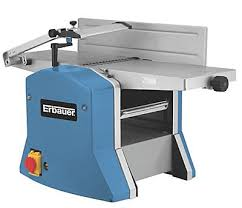Surface Planer (Erbauer ERB052BTE)
| Surface Planer (Erbauer ERB052BTE) | |
|---|---|
 | |
| Sub-category | Woodworking |
| Status | Good working order |
| Last updated | 2 September 2024 07:40:41 |
| Training requirement | yes |
| Training link | lhs-induction-requests channel |
| ACnode | no |
| Origin | Long-Term Loan |
| Location | Wood shop |
| Maintainers | Woodshop team |
A surface planer used for generating a smooth and flat surface on a piece of timber, often starting from warped or rough-sawn timber. It is often followed in use by a thickness planer which produces a parallel surface on the opposite face of the board. Note - in the USA a surface planer is often called a jointer - there the word 'planer' confusingly often refers to a thickness planer
This planer has a maximum cutting width of 200mm and the overall table length is approx. 800mm
The blades for this machine are very expensive and time consuming to sharpen (we have to take them to an external workshop with paid access) - please do not do anything that could damage the cutting edges (see below). If you do notice damage to the blades, please notify the maintainers at the earliest opportunity
Specific rules for this machine:
- Do not adjust the setting of the blades within the cutter head or the height of the outfeed table - setting these is a difficult and time consuming task carried out by the maintainers during a blade change
- Adjusting the fence angle (to produce bevelled edges) is fine, but please set accurately back to 90° afterwards
- Do not use any reclaimed wood (in particular pallet wood) on this machine - even tiny fragments of nails, screws or staples left in the wood will chip the blades
- Try not to plane bark - it usually contains traces of soil or grit which wear the teeth quickly. Use a handheld electric planer to remove the bulk of any bark before taking to the planer
- If your hands need to go anywhere near the blade (particularly when face-planing thin stock) always use a push stick or preferably, a pair of planer paddles
- Always use the planer with the guard installed
This machine requires training and. To arrange training, ask in the 'lhs-induction-requests' channel of our Discord Server
For beginners better to start with Triton Thickness Planer [1] and get familiar with wood working.
Information for Maintainers
This is a Long Term Loan from Toby Molyneux
Risk Assessment - Wood Planers
This risk assessment is intended to provide guidance on the risk associated with the above equipment and activities in normal use. Please also check general risk assessments for the space as a whole. Any discrepancies, errors or concerns should be raised with the document maintainers or trustees - do not edit this assessment directly. For responsible persons and last update, see 'version log' of the assessment page.
Activity
Use of handheld or stationary wood planing equipment such as handheld planers, bench planers (aka jointers) or thickness planers
Signage
Understanding Risk Rating
LOW - Ensure current control measures are in place and continue with activity
MED - Control measures may be adequate, co-supervision is recommended
HIGH - Do not undertake activity without further consultation with area specialists
Risk Assessment
| Identify Hazards | Who May be Harmed and How | Severity | Control Measures | Likelihood | Risk Rating |
|---|---|---|---|---|---|
| Incompetent user | User, bystander | HIGH | Members must not use tools that they are not competent to use. Members must challenge use that they believe is dangerous. Members must read the user manual for this tool. Members must read the risk assessment before using a tool. Members will be advised during induction which tools they will need supervision or an induction to use. Only authorised members will complete maintenance and calibration tasks. | LOW | MED |
| Contact with rotary knives | User | HIGH | Do not put hands within 10cm of blade. Do not push workpiece over blade with hands. Use a push block to push workpiece over cutting area. Use guard to cover unused cutting area. Use guard to cover entire cutting area when thicknesser is being used. Do not insert hands into thicknesser when machine is plugged in. Planer should be turned off immediately after use. | MEDIUM | MED |
| Drawing in (being pulled into the drum) | User | HIGH | User of the thicknesser/planer should not wear gloves, ties, scarves, or other long flowy clothing that could get pulled into the blade. Do not move hands past the blade. Do not use the machine on short stock. | LOW | MED |
| Dust (inhalation, fire, explosion) | User, bystander | MEDIUM | Stationary machines must be used with the workshop dust extractor. An extraction hose must be attached to the machine’s extraction hood, which must be positioned appropriately for use with the thicknesser or planer. Maintenance must include the cleaning of dust from within the unit housing where accessible. Check the extraction hood periodically for blockages. A respirator or mask should be used whilst operating this tool for prolonged periods. | LOW | LOW |
| Noise | User, bystander | MEDIUM | Ear protection is advised. | LOW | LOW |
| Flying splinters | User, bystander | HIGH | Eye protection must be worn In the workshop. Only cut wood, ensuring the workpiece is free from nails, screws or other objects. | LOW | MED |
| Lifting heavy object | User | MEDIUM | The machine must be lifted into a stable position on the working area using correct manual handling procedures. | LOW | LOW |
| Electrocution | User, bystander | HIGH | Do not use if any damage to plug, cables, or machine. | LOW | MED |








